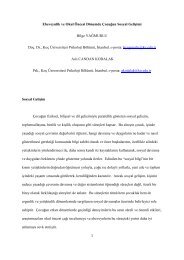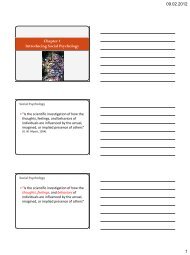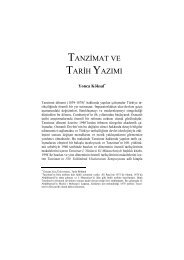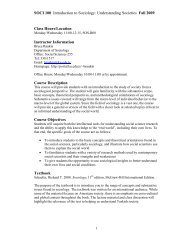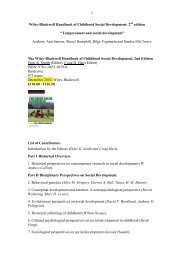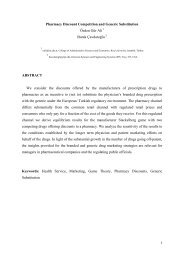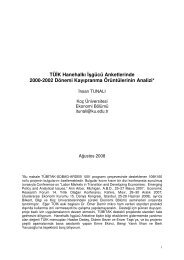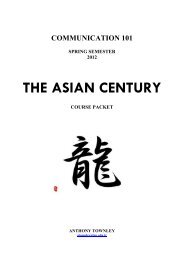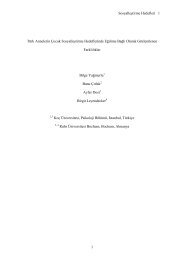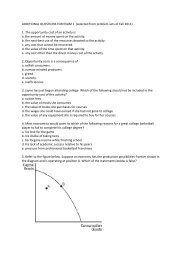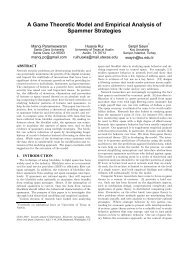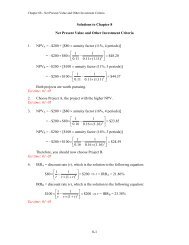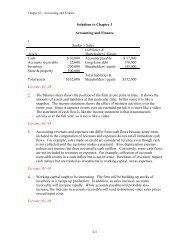The Role of Emotion Regulation in the Treatment of Child Anxiety ...
The Role of Emotion Regulation in the Treatment of Child Anxiety ...
The Role of Emotion Regulation in the Treatment of Child Anxiety ...
Create successful ePaper yourself
Turn your PDF publications into a flip-book with our unique Google optimized e-Paper software.
276 Cl<strong>in</strong> <strong>Child</strong> Fam Psychol Rev (2007) 10:275–293<br />
emotions more <strong>in</strong>tensely than o<strong>the</strong>r children (Suveg<br />
andZeman 2004), and show poor emotion understand<strong>in</strong>g<br />
(Southam-Gerow and Kendall 2000). As noted by Vasey<br />
and MacLeod (2001), anxious children may possess just<br />
as much knowledge <strong>of</strong> good emotion regulation strategies<br />
as most non-anxious children. However, when faced with<br />
a difficult situation, <strong>the</strong>y usually revert to maladaptive<br />
strategies such as avoidance and distraction.<br />
It is expected that anxious children demonstrate some<br />
emotion regulation deficits s<strong>in</strong>ce atypical emotional<br />
experiences have <strong>of</strong>ten been considered a def<strong>in</strong><strong>in</strong>g<br />
characteristic <strong>of</strong> diverse forms <strong>of</strong> psychopathology (Cole<br />
et al. 1994). Despite <strong>the</strong>se considerations, it is surpris<strong>in</strong>g<br />
that more treatment programs do not conta<strong>in</strong> specific<br />
emotion regulation components. Some CBT programs for<br />
anxious children do <strong>in</strong>clude relaxation techniques, which<br />
are aimed at controll<strong>in</strong>g <strong>the</strong> physiological sensation <strong>of</strong><br />
anxiety, and o<strong>the</strong>rs <strong>of</strong>fer education on appropriate facial<br />
expressions associated with different feel<strong>in</strong>g states.<br />
However, ways to regulate emotional states, both positive<br />
and negative emotions, <strong>in</strong> sync with <strong>the</strong> situation<br />
that <strong>the</strong> child is <strong>in</strong> are usually not <strong>the</strong> ma<strong>in</strong> focus <strong>of</strong><br />
<strong>the</strong>rapy and deserve more explicit attention. Although<br />
various authors have suggested <strong>the</strong> importance <strong>of</strong> target<strong>in</strong>g<br />
emotion regulation <strong>in</strong> treatment directly (e.g.,<br />
Davis and Ollendick 2005; Kendall et al. 2000; Samoilov<br />
and Goldfried 2000; Southam-Gerow and Kendall 2002;<br />
Stark et al. 2005), changes <strong>in</strong> emotion regulation skills<br />
are typically not assessed nor specifically “tested” <strong>in</strong><br />
cl<strong>in</strong>ical sett<strong>in</strong>gs or <strong>in</strong> treatment outcome studies. If<br />
anxious children lack <strong>the</strong> skills or demonstrate dysfunctional<br />
skills to regulate <strong>the</strong>ir emotions <strong>in</strong> various situations,<br />
treatment should address <strong>the</strong>se skills as well as <strong>the</strong><br />
dysfunctional cognitions and behaviors associated with<br />
<strong>the</strong>m.<br />
<strong>The</strong> purpose <strong>of</strong> this review is to exam<strong>in</strong>e <strong>the</strong><br />
potential role <strong>of</strong> emotion regulation <strong>in</strong> CBT and <strong>in</strong>troduce<br />
strategies that might be <strong>in</strong>corporated <strong>in</strong>to current<br />
treatment programs for children with anxiety. Some <strong>of</strong><br />
<strong>the</strong> strategies discussed are already be<strong>in</strong>g utilized <strong>in</strong><br />
treatment for anxiety <strong>in</strong> some form, while o<strong>the</strong>rs are<br />
be<strong>in</strong>g used <strong>in</strong> treatment for o<strong>the</strong>r childhood disorders (e.<br />
g., anger management) or with adults. <strong>The</strong> mechanisms<br />
through which <strong>the</strong>se regulatory processes could <strong>in</strong>crease<br />
treatment efficacy are explored, as well as issues <strong>of</strong><br />
measurement. Two anxiety disorders, social anxiety<br />
andpanic disorder, are <strong>the</strong>n reviewed from <strong>the</strong> perspective<br />
<strong>of</strong> possible emotion regulation difficulties<br />
andare usedto highlight how emotion regulation strategies<br />
mightbe utilized <strong>in</strong> treatment. F<strong>in</strong>ally, implications<br />
for <strong>the</strong>rapy <strong>in</strong> cl<strong>in</strong>ical and research sett<strong>in</strong>gs are<br />
highlighted.<br />
<strong>Emotion</strong> and <strong>Emotion</strong> <strong>Regulation</strong><br />
<strong>Emotion</strong>s organize much <strong>of</strong> a child´s experience and<br />
behavior, and are central to most relationships<br />
(Langlois 2004, p.315)<br />
<strong>The</strong> ability to control one’s emotions is a highly valued<br />
characteristic <strong>in</strong> today’s society. A child who is able to<br />
conceal her emotions when receiv<strong>in</strong>g a disappo<strong>in</strong>t<strong>in</strong>g gift is<br />
usually better liked than a child who throws a tantrum or cries<br />
<strong>in</strong> response to receiv<strong>in</strong>g such a gift. Be<strong>in</strong>g able to regulate<br />
one’s emotions <strong>the</strong>refore <strong>in</strong>creases flexibility <strong>in</strong> new situations<br />
and adjustment overall. Currently, researchers are<br />
focus<strong>in</strong>g more and more on <strong>the</strong> development <strong>of</strong> emotions and<br />
<strong>the</strong> process <strong>of</strong> emotion regulation. Despite lack <strong>of</strong> consensus<br />
<strong>in</strong> <strong>the</strong> field about what constitutes “emotion” and “emotion<br />
regulation” (Cole et al. 2004; Thompson 1994), a number <strong>of</strong><br />
studies have been conducted to exam<strong>in</strong>e <strong>the</strong> development <strong>of</strong><br />
emotion regulation, emotion regulation <strong>in</strong> atypical populations,<br />
and biological <strong>in</strong>dicators <strong>of</strong> emotion regulation.<br />
Although <strong>the</strong> scientific study <strong>of</strong> emotion and emotion<br />
regulation is still <strong>in</strong> its <strong>in</strong>fancy, <strong>the</strong>se concepts are<br />
becom<strong>in</strong>g <strong>in</strong>creas<strong>in</strong>gly important for <strong>the</strong> field <strong>of</strong> developmental<br />
psychopathology and cl<strong>in</strong>ical child and adolescent<br />
psychology. S<strong>in</strong>ce emotions organize children’s experience<br />
<strong>in</strong> many ways (Cole et al. 2004), <strong>in</strong>troduc<strong>in</strong>g <strong>the</strong> concept <strong>of</strong><br />
emotion regulation <strong>in</strong>to cl<strong>in</strong>ical research and practice<br />
seems <strong>in</strong>tuitive and may prove to be beneficial. As proposed<br />
by Eisenberg and Sp<strong>in</strong>rad (2004), emotion regulation<br />
can be viewed as a voluntary and goal-directed process<br />
aimed at modify<strong>in</strong>g emotional states to achieve social and<br />
biological adaptation, as well as <strong>in</strong>dividual goals. At its<br />
core, emotion regulation is a process triggered by emotional<br />
arousal <strong>in</strong> an attempt to modulate and manage <strong>the</strong><br />
arousal. In light <strong>of</strong> <strong>the</strong> nature <strong>of</strong> psychopathology, <strong>the</strong>rapy<br />
should aim at enhanc<strong>in</strong>g efficient emotion regulation skills<br />
elicited by <strong>in</strong>tense negative emotions and <strong>the</strong> lack <strong>of</strong><br />
positive affect.<br />
<strong>Emotion</strong><br />
Although it has been suggested that emotions cannot “exist<br />
<strong>in</strong> an unregulated manner” (Campos et al. 2004, p. 378),<br />
emotions and emotion regulation are def<strong>in</strong>ed here separately<br />
<strong>in</strong> order to provide a work<strong>in</strong>g def<strong>in</strong>ition <strong>of</strong> <strong>the</strong>m.<br />
<strong>Emotion</strong>s are def<strong>in</strong>ed as biologically endowed processes<br />
that allow for a quick appraisal <strong>of</strong> situations and appropriate<br />
responses <strong>in</strong> order to ma<strong>in</strong>ta<strong>in</strong> favorable or to<br />
term<strong>in</strong>ate unfavorable conditions (Cole et al. 2004). <strong>The</strong><br />
nature <strong>of</strong> <strong>the</strong> appraisal determ<strong>in</strong>es <strong>the</strong> quality <strong>of</strong> <strong>the</strong><br />
emotion (negative or positive emotions) and <strong>the</strong> degree <strong>of</strong><br />
123



